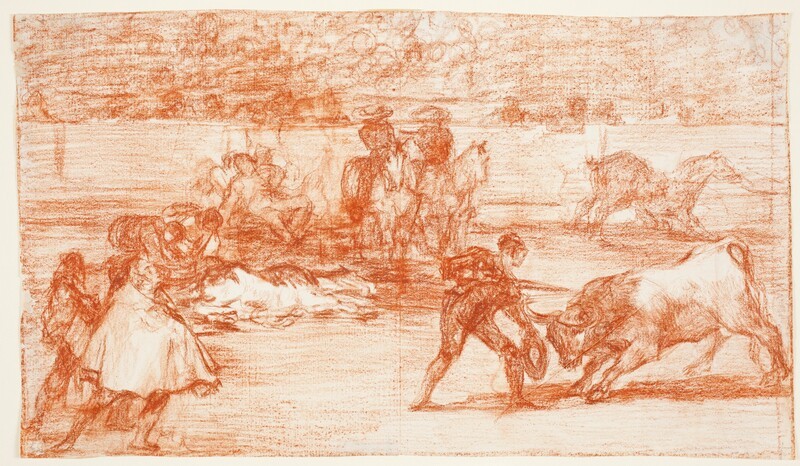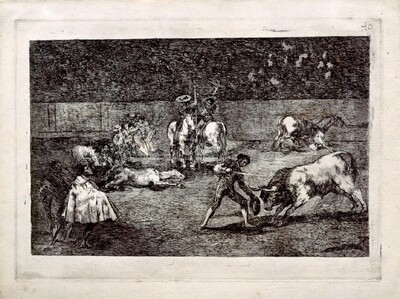- Cronología
- Ca. 1814 - 1816
- Ubicación
- The Prado National Museum. Madrid, Madrid, Spain
- Dimensiones
- 185 x 322 mm
- Técnica y soporte
- Reconocimiento de la autoría de Goya
- Documented work
- Titular
- El Prado National Museum
- Ficha: realización/revisión
- 03 Oct 2021 / 22 Jun 2023
- Inventario
- (D4326)
- Otros títulos:
-
5 [...] (recto, lower left-hand side)
248 [adhesive envelope] ( verso, lower part)
248 [envelope fragment of paper adhered, cut] (verso, upper right side)
See How the ancient Spaniards hunted bulls on horseback in the countryside.
This preparatory drawing passed by inheritance in 1828 to Javier Goya, the painter's son, and in 1854 to Mariano Goya y Goicoechea, the artist's grandson. It was subsequently owned by Valentín Carderera (ca. 1861) and Mariano Carderera (1880). In 1886 it was acquired from Mariano Carderera, along with many other drawings by Goya, including almost all the preparatory studies for the Bullfight, by the Directorate General of Public Instruction, and was assigned to the Prado Museum, where it entered on 12 November 1886.
See How the ancient Spaniards hunted bulls on horseback in the countryside.
Preparatory drawing for the print A bullfighter entering to kill with a hat in his hand instead of a muleta (Bullfighting I) , a print that was not included in the official series of the Bullfighting , although two state proofs of it have been preserved, but not the plate.
As in the two state trials, the scene is one of great confusion, something that Gassier believes corresponds to Goya's desire to reflect the reality of the suerte de matar. The arena is full of people and horses, one of them dead, and there is a wounded picador in the background. Two other picadors are also shown motionless on their mounts, also in the background, and the rest of the cuadrilla is ready to perform. The most prominent point in the drawing is occupied by the bullfighter, who is preparing to enter to kill with a rapier in his right hand and a hat in his other hand instead of a muleta, the risk being consequently greater because the bull can charge more easily. In the background of the scene we see the bullring outlined. The light falls especially on the dead horse and the bull, illuminating more the front part of the drawing which, as the two preserved state proofs show, was transferred to the plate, and therefore to the print, with remarkable fidelity.
The paper still has creases from the press.
-
Los dibujos de GoyaMuseo Provincial de ZaragozaZaragoza1978exhibition organized by Museo Provincial de Zaragoza, Ministerio de Cultura and Ayuntamiento de Zaragoza, exhibition guide written by Miguel Beltrán Lloris and Micaela Pérez Sáenz. October 1978pp. 36-37, cat. 94
-
Madrid1990cat. 60-61
-
Madrid2005cat. VI
-
MadridBlass S.A.1918p. 140
-
1941pp. 185-186
-
1946pp. 177-216, espec. pp. 214-215
-
BarcelonaTartessos-F. Oliver Branchfelt1946 (reed. 1951)
-
MadridMuseo del Prado1954cat. 189
-
ParísLe Club Français du Livre1963p. 187
-
OxfordBruno Cassirer1964vol. II, 1964, p. 359, cat. 245
-
Vie et ouvre de Francisco de GoyaParísOffice du livre1970p. 281, cat. 1236
-
Barcelona1974p.21
-
Dibujos de Goya, 2 volsBarcelonaNoguer1975pp. 420-421, cat. 285
-
MilwakeeMilwaukee Art Museum1986p. 20
-
Goya en la Fundación Lázaro GaldianoMadridFundación Lázaro Galdiano1999p. 186, cat. 43
-
MadridMuseo Nacional del Prado2001p. 108

